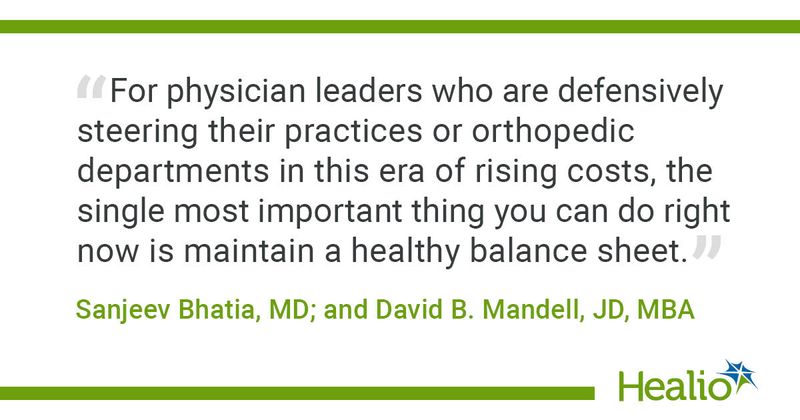How inflation may affect your practice and finances, steps to take now
In the last 12 months, there has been a plethora of factors that have inched up the consumer price index, the key gauge the Federal Reserve uses as a barometer of inflation.
In a 2021 column, we defined inflation as the general increase in cost of products and services, as well as a decline in the purchasing value of money. A simple way to understand the root causes of this phenomenon is that too many dollars end up chasing too few goods.

In this month’s column, we expand on this discussion and explore how inflationary forces may impact the practice of medicine, as well as physician finances. Additionally, we discuss precautions physicians can take now to safeguard their assets and position themselves for opportunities in the new economy.
Inflation’s status, effect on economy
The consumer price index in March 2022 reached 8.5%, which indicates that, year-over-year, prices on most consumer goods rose 8.5%. The producer price index reached 11.2% in March, a sign that higher prices may still be on the horizon as producers have been hit with higher price increases than have been reflected on the consumer side.


One of the challenges with a rising inflationary environment is that it mandates the Federal Reserve raise the federal funds rate to slow demand in order to bring the economy closer to their target inflation rate of 2%. At present, Federal Reserve chair Jerome Powell has insisted the federal government will take a gradual approach to raising rates while trying to have a “soft landing.” However, many who lived during the 1970s and 80s, the last major period of inflation, remember how then-Federal Reserve chair Paul Volcker had to jack rates to nearly 20% to tame inflation – an action that resulted in a recession.
How inflation may affect practices
Whether in private practice or hospital employed, there is no doubt that a rapidly rising inflationary environment can have negative consequences for health care providers. For starters, the costs of employee wages, including ancillary providers, as well as goods and services, will continue to rise, squeezing already thin margins. This margin compression, defined in economic terms as having input costs rise faster than the sale of a product, potentially could force layoffs or restructuring of human resources if the costs of employment for the practice become unsustainable. Such consequences could negatively affect the quality and access to care being delivered to our patients.
One of the biggest challenges in modern medicine is that most health care practices and facilities today, except for some concierge or out-of-network services, have limited or nonexistent pricing power due to their dependence on insurance or third-party reimbursements for services. Pricing power is defined as the ability to raise prices without curtailing demand or losing share to a competitor. Unfortunately for most physicians, it is difficult to keep their reimbursements in line with current market conditions because insurance-related reimbursement is frequently out of their hands. Compensation for physician services is complex but is usually directly or indirectly tied to the Medicare conversion factor (CF), the number of dollars assigned to a relative value unit. Calculation of the CF is based on the overall state of the economy, the number of Medicare beneficiaries and other regulations that may lag current market conditions by several years. As such, in an inflationary environment, physician margins could be squeezed considerably in the near-term if the current accelerated pace of inflation does not subside.
Steps to take now: Your practice
For physician leaders who are defensively steering their practices or departments in this era of rising costs, the single most important thing you can do right now is maintain a healthy balance sheet. Excessive debt is prone to rising debt service costs and the viability of your business may hinge on the ability to stay cash flow-positive during times of margin compression. Practice leaders should also explore ways to use new technology to optimize efficiency and throughput while still delivering the same or higher level of care. Lastly, it is imperative to maintain a quality physician workforce and potentially innovate payment models to incentivize younger physicians who bring value or unique skills.
Steps to take now: Your finances
Navigating your finances in a high inflationary environment is one of the most challenging things to do as many asset classes may struggle. Consult your financial advisor for guidance and be sure they understand the current environment well. From a personal balance sheet standpoint, reducing debt costs, particularly high interest variable debt costs, such as credit card debt or personal loans, may be most critical. For personal investments, one should understand that growth stocks, typically those with high price to earnings multiples, are frequently subject to multiple contractions in inflationary environments, which may force stagnant or declining stock prices. Stocks of companies with pricing power, good balance sheets and low price to earnings multiples — typically the value breed of companies — may have the best chance of performing well. Other asset classes that do well with inflation include certain commodities, real estate and treasury inflation protected securities. Cryptocurrencies, like bitcoin (BTC) which have a finite number of coins to be mined, may also theoretically do well with inflation, but BTC is often deemed a high-risk investment by institutions and could be the first to be sold during market downturns.
Inflation, like it or not, is real and the extent of our current risks will not be known for many more months. Regardless, physicians of all ages should understand the effects of rising input costs on overall health care economic conditions. Be sure to maintain a healthy balance sheet both personally and professionally and manage changing risk profiles within your investment portfolio to best position yourself and your practice for new opportunities.
References:
Supplier prices rose 11.2% from a year ago in March, the biggest gain on record. www.cnbc.com/2022/04/13/producer-price-index-march-2022-.html
Seidenwurm DJ, et al. AJNR Am J Neuroradiol. 2014;doi:10.3174/ajnr.A3674.
What orthopedists need to know about inflation. www.healio.com/news/orthopedics/20210618/what-orthopedists-need-to-know-about-inflation
Wealth Planning for the Modern Physician and Wealth Management Made Simple are available free in print or by ebook download by texting HEALIO to 844-418-1212 or at www.ojmbookstore.com. Enter code HEALIO at checkout.
For more information:
Sanjeev Bhatia, MD, is an orthopedic sports medicine surgeon practicing at Northwestern Medicine in Warrenville, Illinois. He can be reached at sanjeevbhatia1@gmail.com or @DrBhatiaOrtho.
David B. Mandell, JD, MBA, is an attorney and founder of the wealth management firm OJM Group www.ojmgroup.com. You should seek professional tax and legal advice before implementing any strategy discussed herein. He can be reached at mandell@ojmgroup.com or 877-656-4362.

